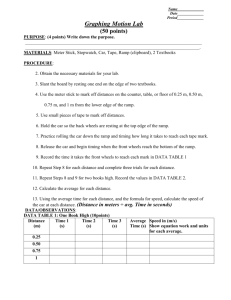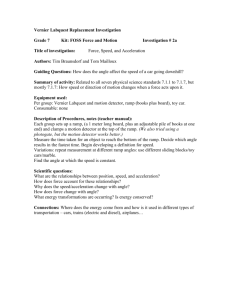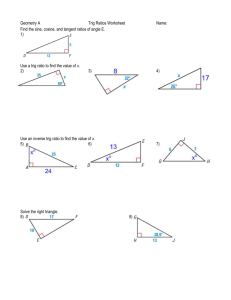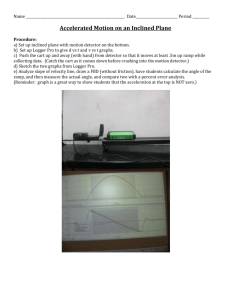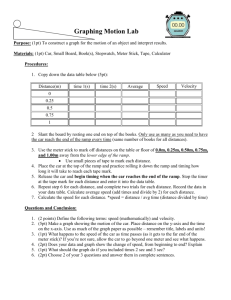Document 14137214
advertisement
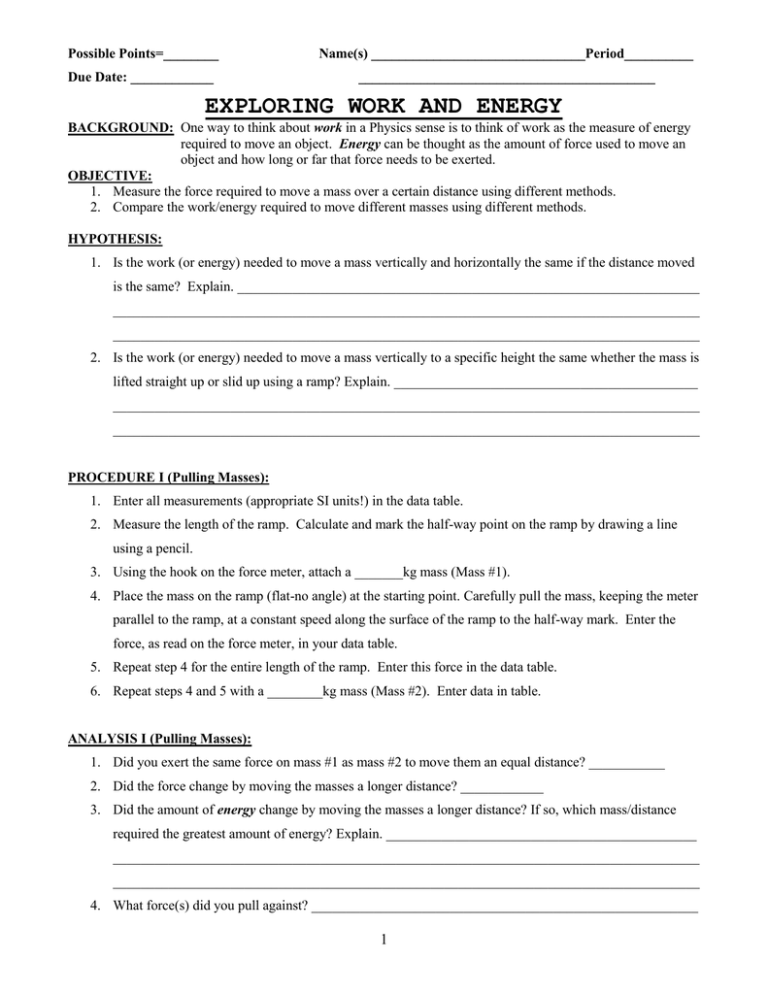
Possible Points=________ Name(s) _______________________________Period__________ Due Date: ____________ ___________________________________________ EXPLORING WORK AND ENERGY BACKGROUND: One way to think about work in a Physics sense is to think of work as the measure of energy required to move an object. Energy can be thought as the amount of force used to move an object and how long or far that force needs to be exerted. OBJECTIVE: 1. Measure the force required to move a mass over a certain distance using different methods. 2. Compare the work/energy required to move different masses using different methods. HYPOTHESIS: 1. Is the work (or energy) needed to move a mass vertically and horizontally the same if the distance moved is the same? Explain. ___________________________________________________________________ _____________________________________________________________________________________ _____________________________________________________________________________________ 2. Is the work (or energy) needed to move a mass vertically to a specific height the same whether the mass is lifted straight up or slid up using a ramp? Explain. ____________________________________________ _____________________________________________________________________________________ _____________________________________________________________________________________ PROCEDURE I (Pulling Masses): 1. Enter all measurements (appropriate SI units!) in the data table. 2. Measure the length of the ramp. Calculate and mark the half-way point on the ramp by drawing a line using a pencil. 3. Using the hook on the force meter, attach a _______kg mass (Mass #1). 4. Place the mass on the ramp (flat-no angle) at the starting point. Carefully pull the mass, keeping the meter parallel to the ramp, at a constant speed along the surface of the ramp to the half-way mark. Enter the force, as read on the force meter, in your data table. 5. Repeat step 4 for the entire length of the ramp. Enter this force in the data table. 6. Repeat steps 4 and 5 with a ________kg mass (Mass #2). Enter data in table. ANALYSIS I (Pulling Masses): 1. Did you exert the same force on mass #1 as mass #2 to move them an equal distance? ___________ 2. Did the force change by moving the masses a longer distance? ____________ 3. Did the amount of energy change by moving the masses a longer distance? If so, which mass/distance required the greatest amount of energy? Explain. _____________________________________________ _____________________________________________________________________________________ _____________________________________________________________________________________ 4. What force(s) did you pull against? ________________________________________________________ 1 PROCEDURE II (Lifting Masses): 1. Hold your meter stick vertically next to the ramp with the zero end at the bottom. 2. Attach the force meter to mass #1. Place mass #1 on the table beside the meter stick. Carefully lift the mass vertically at a constant speed a distance equal to half the ramp distance (see part I). *Be careful not to touch the meter stick! Record the force meter reading in table. 3. Repeat step 2 lifting a distance equal to the entire length of the ramp (see part I). Record force. 4. Repeat steps 2 and 3 for mass #2. Record data. ANALYSIS II (Lifting Masses): 1. Did you exert the same force on mass #1 as mass #2 to move them an equal height? ___________ 2. Did the force change by moving the masses to a greater height? ____________ 3. Did the amount of energy change by moving the masses to a greater height? If so, which mass/height required the greatest amount of energy? Explain. _____________________________________________ _____________________________________________________________________________________ _____________________________________________________________________________________ 4. What force(s) did you lift against? _________________________________________________________ 5. In general, what conclusions can you make regarding the energy required to lift or to pull a mass a specified distance? _____________________________________________________________________ _____________________________________________________________________________________ _____________________________________________________________________________________ _____________________________________________________________________________________ _____________________________________________________________________________________ PROCEDURE III (Inclined Plane): 1. Hold the inclined plane at an angle to the table so that the height of the end of the ramp is equal to the half-way length (see procedure I) of the ramp. 2. Attach mass #1 to the force meter and place at the bottom of the ramp. Pull the mass up the ramp making sure you keep the meter parallel to the ramp. Record displacements and force in table. 3. Repeat step 2 with mass #2. Record data. 4. Repeat step 2 and 3 for an angle of incline that is double the original angle. Record data. ANALYSIS III (Inclined Plane): 1. Did you exert the same force on mass #1 as mass #2 to move them up the ramp? ___________ 2. Did the force change when the angle changed? ____________ 2 3. Did the amount of energy change by moving the masses at a different angle? If so, which mass/angle required the greatest amount of energy? Explain. _____________________________________________ _____________________________________________________________________________________ _____________________________________________________________________________________ 4. What force(s) did you pull against? ________________________________________________________ 5. Compare the force required to lift a mass using an inclined plane with the force required to lift the same mass to the same vertical displacement using only the force meter. Why are the values different? __________________________________________________________________________________________ __________________________________________________________________________________________ __________________________________________________________________________________________ 6. a. If your ramp was made ten times longer, what would happen to the amount of force required to move your mass if you still achieved the same vertical displacement? ___________________________________________ __________________________________________________________________________________________ b. In terms of energy, is there a difference in the amount of energy needed before and after your adjustment? Explain. __________________________________________________________________________________ __________________________________________________________________________________________ __________________________________________________________________________________________ Closing Comments: In the space provided, make GENERAL summary conclusions/comparisons in regards to the measure of force and energy required in moving an object for all three cases: moving horizontally, moving vertically, and moving at an angle. ________________________________________________________________________________________________ ________________________________________________________________________________________________ ________________________________________________________________________________________________ ________________________________________________________________________________________________ ________________________________________________________________________________________________ ________________________________________________________________________________________________ ________________________________________________________________________________________________ ________________________________________________________________________________________________ ________________________________________________________________________________________________ ________________________________________________________________________________________________ ________________________________________________________________________________________________ 3 4 DATA TABLE MASS #1 MASS #2 (___________Kg) (____________Kg) RAMP HALF LENGTH FULL LENGTH HALF LENGTH FULL LENGTH LENGTH (___________cm) (___________cm) (___________cm) (___________cm) INCLINED ANGLE #1 ANGLE #2 ANGLE #1 ANGLE #2 PLANE (________degrees) (________degrees) (________degrees) (________degrees) ____________cm ____________cm ____________cm ____________cm PULLING FORCE (N) LIFTING FORCE (N) HEIGHT INCLINED FORCE (N) 5
